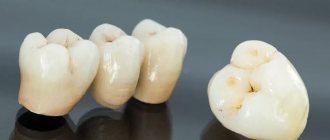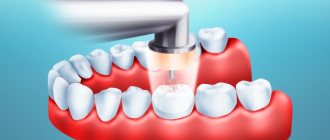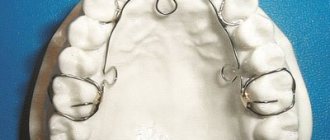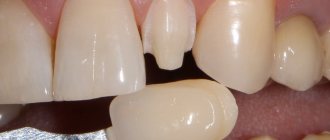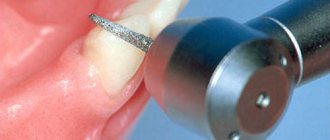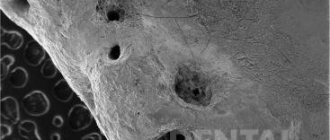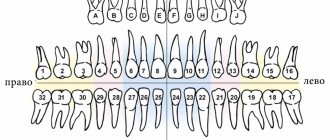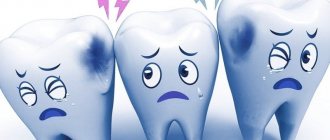144
The principle of minimally invasive effects on the patient’s body during treatment began to be promoted especially actively in medicine at the end of the last century.
In dentistry, it has been developed in the form of methods for preparing hard and soft tissues of the oral cavity, such as chemical-mechanical, air-abrasive, ultrasonic and laser.
Compared to traditional methods, these technologies provide increased treatment efficiency, minimal invasiveness, and maximum patient comfort.
Special purpose
Rondoflex (air-abrasive tip) is a device for preparing hard tooth tissues with an abrasive-air mixture containing aluminum oxide powder.
At its technological essence, this is a device for sandblasting. Rondoflex is produced by the German company KaVo Dental, specializing in the production of various dental equipment.
The device consists of the following main parts:
- The air-abrasive tip itself , in which the abrasive mixture is prepared and fed into the nozzle of the nozzle (cannula).
- Abrasive container screwed to the back of the Rondoflex.
- The nozzle (cannula) is a tube from which a focused air-abrasive stream emerges. Attaches to the front of the handpiece.
- Connections for connecting air and water supplies.
The device is activated by a stream of compressed air. When fed into the line, the latter sucks in the abrasive from a container attached to the back of the tip using the ejector principle.
Next, the air-abrasive mixture is mixed with water, forming a spray that flies out of the cannula nozzle onto the tooth being treated. As a result of the collision of abrasive particles with tooth tissues, they are destroyed.
Water prevents dust formation and washes away destroyed pathological tissue from the prepared surface. In this case, unlike boron, the tooth is not heated to temperatures that cause burns.
Rondoflex is intended for use exclusively in therapeutic, prosthetic and orthodontic dentistry. With his help:
- open and expand the deep fissures of the tooth, preparing them for sealing;
- treat small carious cavities using a drill instead;
- prepare the surface of dentin and enamel for the application of adhesives, cements and composites for filling.
- remove residual dental materials from crowns, bridges, and orthodontic devices.
Rondoflex is a minimally invasive, patient-friendly and effective alternative to the drill. It is mainly used to remove small volumes of hard dental tissues and dental materials.
What is a portable dental drill and how it works.
Come here if you are interested in the technique of treating dental cysts under a microscope.
At this address https://www.vash-dentist.ru/lechenie/zubyi/kogda-trebuetsya-perelechivanie.html we will talk about the cost of tooth canal retreatment.
How often do you need to brush your teeth with Air Flow?
Experts recommend visiting the clinic for professional hygienic treatment at least once every six months if the following factors are present:
- active smoking;
- excessive consumption of strong tea or coffee;
- crowded teeth;
- undergoing a course of treatment of bite defects using a brace system.
Otherwise, Air Flow cleaning should be done once a year. This will prevent caries and visually make your teeth lighter.
Note: professional enamel cleaning should not be confused with enamel whitening. The whitening procedure involves treating pigmentation with chemicals. For example, during the Zoom-4 procedure, such a substance is hydrogen peroxide, which, under the influence of a special lamp, can whiten the enamel layer by 8 to 10 tones. When using the Air Flow method, the dentition becomes visually lighter due to its release from external contamination (ingrained plaque).
The network of dental clinics “Smile” offers professional dental cleaning services with Air Flow. We have family and cumulative discounts. Our doctors are highly qualified and continue to improve their skills in leading Russian and European dental clinics. The level of medical services provided in our centers meets international standards.
Branches of our orthodontic center are located in Moscow within walking distance from the metro:
- Art. Alekseevskaya (VDNKh district, etc. Mira), address: st. 3rd Mytishchiskaya house 3, building 2;
- Art. Shelepikha, address: Shelepikhinskaya embankment, address: building 34, building 1.
We will make your smile snow-white! Come to us for beauty and health!
Equipment and technical characteristics
The Rondoflex device is supplied with the following components:
- the device itself is an air-abrasive tip;
- two cannulas (for powders of different fractions);
- two empty powder containers connected to the tip;
- two containers with powder;
- cleaning rod for cleaning the tip;
- cannula key;
- needle (mandrin) – rod for cleaning the cannula.
The powder remaining in the containers connected to the tip can be used for reprocessing.
Technical characteristics of Rondoflex:
- driving air pressure – 3.2–6.0 atm.;
- water pressure – 1.5 atm.;
- air flow – 5-11 normal liters/min (depending on the size of the cannula nozzle);
- water consumption – 35-45 ml/min;
- The sizes of aluminum oxide granules are 27 microns for gentle preparation, 50 microns for aggressive preparation.
Rondoflex is connected to air and water lines using MultiFlex adapters.
Indications for use
Rondoflex can be used in all cases where the removal of a limited amount of hard tooth tissue and materials is required, as well as to prepare the surface of dentin and enamel for the application of adhesive, composite or cement.
Indications for its use are the following clinical situations:
- Deep fissures. Rondoflex is used for invasive fissure sealing.
- Superficial, initial stage of caries , characterized by a small area and shallow depth of damage.
- Moderate and deep caries. In this case, the device can be used as an addition to a drill - to treat individual areas that are difficult to prepare with a bur, and to reduce invasiveness.
- Filling carious cavities and defects of non-carious origin. Rondoflex increases the porosity of surfaces, thereby increasing the adhesion of filling materials.
- The presence of excess glue, sealer and other dental materials on teeth, bridges, crowns, and orthodontic devices. Sandblasting carefully removes excess material without disturbing the integrity of the underlying surface.
Rondoflex is not effective for:
- the need to remove large volumes of dental tissue;
- deep caries or its spread below the gums;
- carious cavities of complex relief;
- lack of visual control of the preparation area.
A disadvantage of Rondoflex can also be considered the uneven removal of different tooth tissues - too fast - dentin, too slow - enamel. And also the lack of tactile feedback.
Indications and contraindications
Indications:
- Prevention of caries
- Before dentures with crowns or implants (for correct selection of denture color)
- Before installing braces
- Before performing ZOOM-4 whitening (to obtain a uniform effect)
- When symptoms of periodontal disease appear
- The need to clean the braces system
- Pigmentation of enamel with natural or artificial dyes
- Excessively crowded arrangement of elements in the dentition
Contraindications:
- Allergy to baking soda
- Children's age (up to 10 years)
- Diseases of the ENT organs accompanied by nasal congestion
- Bronchial asthma
- Chronical bronchitis
- Inflammation of gingival tissue in acute form
Advantages of the device
Rondoflex has a number of significant advantages compared to a drill, although it cannot replace it in all cases:
- invasive , the most gentle preparation.
- Versatility. Can be used either alone or in combination with a drill.
- Comfort for the patient – absence of vibration, pain from burns.
- High surface quality regarding adhesion .
The surface subjected to sandblasting has a 5-6 times larger area compared to that processed in the traditional way. There is no smear layer. This significantly increases the adhesion strength of dental materials to dentin and tooth enamel. - Long service life of restorations - for the above reason.
- Better modeling of the treated surface. The configuration change occurs more slowly than when working with a bur.
- Availability of reliable protection against abrasive powder - water, latex and liquid rubber dam.
Summing up the review of the advantages of the Rondoflex device, it should be said that air-abrasive preparation takes longer than traditional, but significantly exceeds it in the subtlety of its effect on dental tissues, eliminates contamination and smearing of the prepared surface, and makes the procedure more comfortable for the patient.
How does Air Flow cleansing work?
Before starting the procedure, the doctor conducts a visual examination of the oral cavity to identify local contraindications - the presence of caries, acute inflammation of the mucous tissues.
Then it evaluates the degree of contamination of the surface of the teeth. If there are hard deposits of tartar, the dentist removes them with an ultrasonic scaler. And only after this he begins to remove the soft plaque with the professional Air Flow system, treating each element separately with a circular motion using the device’s nozzle. Upon completion of cleansing, the doctor polishes the enamel with special brushes. Dentist advice:
- In order to strengthen and improve the health of tooth enamel, after hardware treatment it should be coated with a fluoride-containing composition. Do not refuse this procedure when your doctor suggests it;
- Do not drink, eat or smoke for 3 hours after the procedure to avoid hyperpigmentation of the enamel layer.
Operation, Recommendations and Warnings
Preparing Rondoflex for work involves performing the following actions and rules:
- The device requires dry, clean air to operate.
- The abrasive container installed on the tip should be half filled with aluminum oxide, which corresponds to approximately 20 g.
- The device must be connected to a cannula of a size corresponding to the abrasive used, and fittings for supplying water and air.
Before using the device for the first time, to set up and get used to it, it is advisable to work on disposable glass. First, a recess is made with a focused stationary jet. Why do you roughen glass using movements reminiscent of working with a brush?
There are two modes of operation of the device - in the oral cavity and outside it.
Directions for use in the oral cavity
All surfaces adjacent to the treated surface must be protected with latex and liquid rubber dam.
The cannula nozzle should be at a distance of 1-2 mm from the surface being prepared. The focused stream of spray should fall on the tooth at an angle of 90°.
When using the device, it is necessary to avoid contact of the air-abrasive mixture with soft tissues , as well as with teeth that are not planned to be prepared.
Let's consider the stages of endodontic tooth treatment and possible difficulties in the process.
This publication presents a protocol for root canal irrigation.
Here https://www.vash-dentist.ru/lechenie/zubyi/pritselnyiy-snimok.html all the most important things about how to take targeted photographs of teeth.
Non-oral use
Extraoral work may be necessary when removing residual materials from dentures, crowns, and orthodontic devices. In this case, you should pay attention to ensure that the air-abrasive mixture does not fall on the devices, tools and materials surrounding the workplace.
It is necessary to use suction devices (vacuum cleaner), and cover objects that may fall under the stream with a napkin. Objects that are particularly sensitive to dust should be removed from the treatment area altogether.
Disinfection and storage conditions
The device must be cleaned and disinfected after each use. External and internal, manual and machine cleaning and disinfection are used.
The very first cleaning operation is to blow air through the tip with an empty container of abrasive for 3 seconds.
External manual treatment involves wiping the device with a napkin soaked in a disinfectant, cleaning the external surfaces with a toothbrush with medium-hard bristles using baking soda, and rinsing with drinking running water.
For manual internal cleaning, you must disconnect the cannula and clean it and the tip separately.
Cleaning the cannula is carried out with a needle inserted by turning the cannula in front and behind, after which the latter is washed with running drinking water. The tip is cleaned with a cleaning rod. There should be no drops of water on the cleaned device (you need to blow it with air).
If the delivery set includes special disinfectant aerosols (KaVo DrySpray and KaVo CleanSpray - not available in all countries), the internal cavities of the tip are treated with these agents.
The adapter is connected and sprayed with KaVo CleanSpray aerosol 3 times for 2 seconds, after which it is washed with KaVo DrySpray.
If these means are not available, disinfection is carried out using thermal disinfectors according to the instructions (the cannula and other elements of the device are placed in a bag and placed in a thermal disinfector for a certain time).
Rondoflex should be stored in a dry, cool, dust-free, sterile place.
The video provides additional information on the topic of the article.
Advantages and disadvantages of the method
The advantages of professional hardware cleaning are multifaceted:
- thorough hygienic treatment of prosthetic and orthodontic systems (crowns, bridges, braces, etc.);
- the ability to clean not only the supragingival part of the tooth, but also the subgingival part (up to 5 mm);
- efficiency of execution (about 30 minutes);
- absence of discomfort and pain;
- elimination of pigmented areas;
- slight lightening of the enamel shade (by 1 – 2 tones);
- eliminating unpleasant odors caused by plaque accumulation.
This method has one drawback - the inability to clean tartar deposits. Its density is so high that the force of a directed jet of water mixture is not enough to crush it.
Reviews
Preparation of carious cavities with a drill (“drilling”) is one of the most unpleasant dental procedures. Replacing it with sandblasting using the Rondoflex device eliminates severe discomfort.
If you have had your teeth treated using Rondoflex, please tell us about your experience. How different were they from “drilling” with a bur? What is your general impression of the procedure? You can leave a comment at the bottom of the page.
If you find an error, please select a piece of text and press Ctrl+Enter.
Tags: devices, toothache
Did you like the article? stay tuned
Previous article
Megagen implants from Korea - almost one hundred percent success at a low price
Next article
High-quality and inexpensive Italian Duravit implants
What is Air‑Flow
Air‑Flow (“Air‑Flow”) is an innovative teeth cleaning system. The procedure is carried out using a sandblasting machine, which, under high pressure, delivers a special fine powder with water from a thin nozzle. This helps get rid of pigmented plaque and also polish the surface of the teeth.
The Air‑Flow system is part of professional oral hygiene and is used before ultrasonic teeth cleaning.
Features of brushing teeth using the Air‑Flow method
- Soft plaque is completely removed in one procedure
- Brushing your teeth with this system takes no more than 30 minutes.
- The microparticles used in the paste are safe and hypoallergenic
- Air‑Flow teeth cleaning is painless
- Suitable for cleaning surfaces of orthopedic structures

